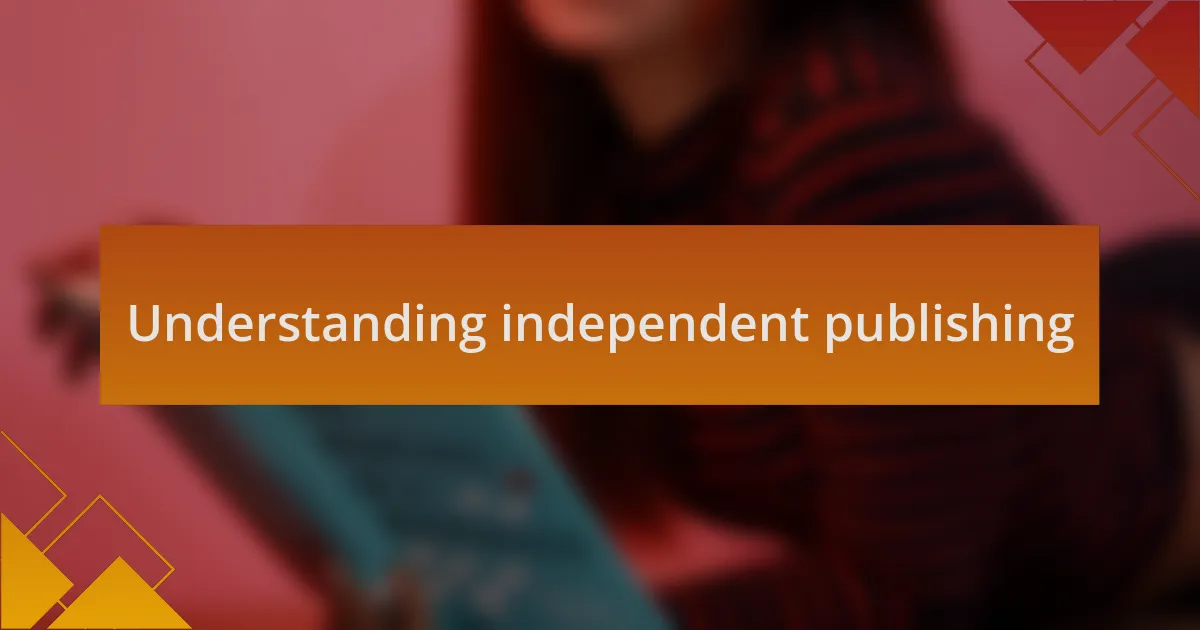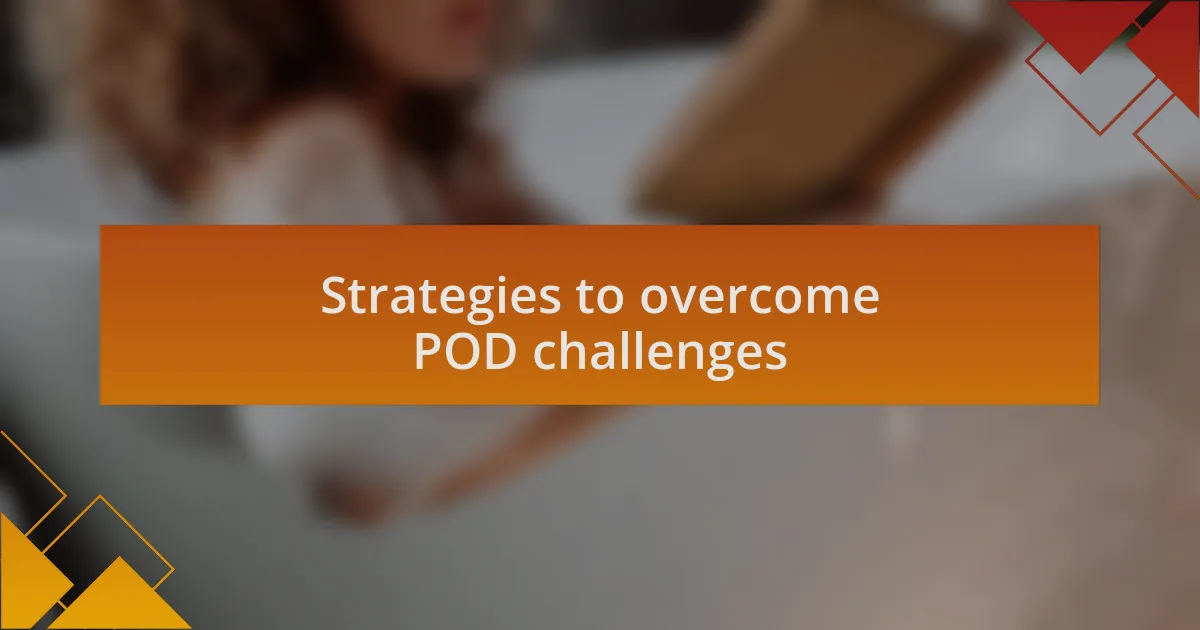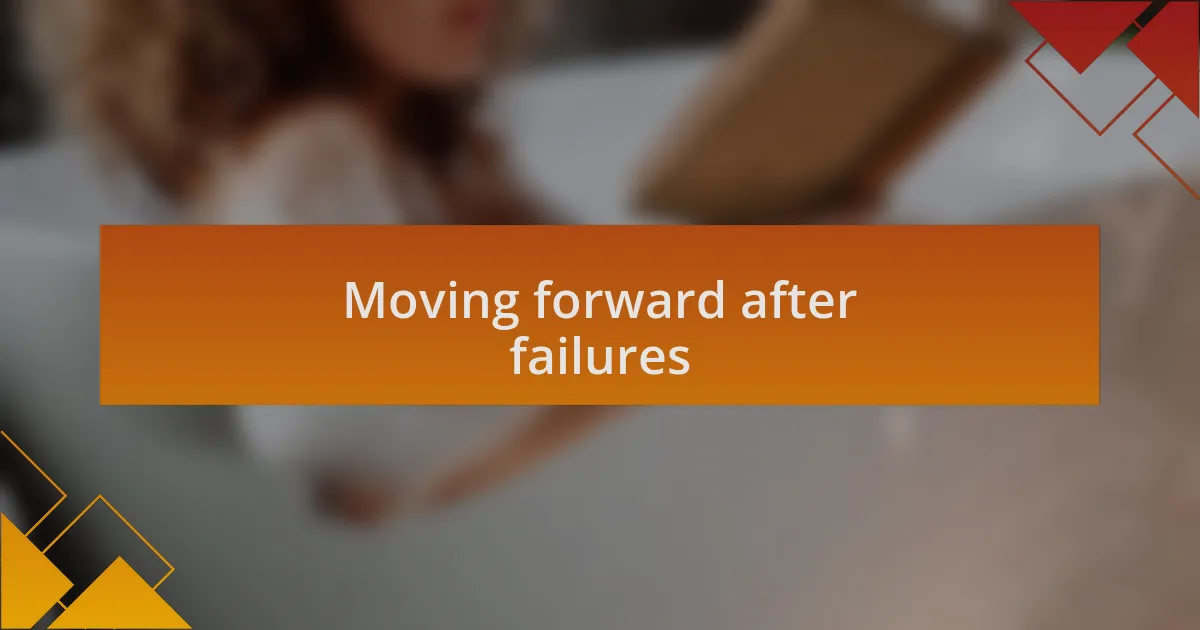Key takeaways:
- Independent publishing allows authors to maintain creative control and directly engage with their audience, fostering a supportive community.
- Print on demand (POD) minimizes financial risk and environmental impact by producing only what is sold, providing flexibility for updates and revisions.
- Common failures in POD include production quality issues, inadequate marketing strategies, and unrealistic pricing expectations.
- Learning from mistakes, such as the importance of proofreading and diversifying print providers, is crucial for overcoming challenges and enhancing future success.

Understanding independent publishing
Independent publishing offers a unique avenue for authors to share their work without the constraints imposed by traditional publishing houses. I remember the thrill of holding my first self-published book, feeling an exhilarating blend of freedom and vulnerability. Have you ever experienced that moment when your hard work transforms into something tangible? It’s an indescribable joy.
Understanding independent publishing means recognizing the vast opportunities it presents for creativity and expression. However, it also comes with its own set of challenges. I once underestimated the importance of marketing; my book was great, but without visibility, it felt like shouting into a void. What strategies have you considered to get your voice heard in this crowded arena?
At its core, independent publishing empowers authors to tell their unique stories on their terms. I often reflect on how this freedom has not only shaped my writing style but also deepened my connection with my audience. Doesn’t it feel rewarding to directly engage with readers who resonate with your message? That’s the beauty of independent publishing—it’s not just about distribution; it’s about building a community around your passion.

Importance of print on demand
Print on demand (POD) revolutionizes how we approach publishing, making it more accessible for authors like us. I vividly recall the first time I printed a limited run of my book through a POD service. The ability to print only as many copies as I needed not only minimized financial risk but also allowed me to test the market responses. Have you ever thought about how crucial it is to retain control over inventory and production costs?
Another critical aspect of POD is its environmental impact. It reduces waste by only producing books that are sold. In my experience as a seasoned self-publisher, this sustainable approach appealed to both my conscience and my readers’ values. Isn’t it encouraging to know that your publishing choices can align with a vision of sustainability?
The flexibility that print on demand offers cannot be overstated. When I wanted to update content, I could easily do so without being tied to a large print run. Just last year, I revised my book, adding fresh insights and new chapters based on reader feedback. How liberating is it to know that your work can evolve and grow based on your journey? This adaptability is vital in today’s fast-paced world.

Common failures in POD
When considering common failures in print on demand, one major pitfall is underestimating production quality. I once received a batch of books with misaligned text and faded images. It was disheartening to see my hard work come out looking unprofessional. Have you ever felt that sinking feeling when a project’s outcome doesn’t match your vision?
Another frequent mistake is neglecting the importance of marketing. I learned the hard way that simply having a great book isn’t enough. If readers don’t know about it, my masterpiece might as well be sitting on a shelf, gathering dust. I remember launching my book without a clear marketing strategy and watched as it slipped into obscurity. What good are beautifully printed pages if no one sees them?
I’ve also seen many authors falter due to unrealistic expectations about pricing and royalties. Initially, I believed my book could retail at a price with which I’d barely break even, thinking readers would flock to it just because it was available. It wasn’t until I ran the numbers that I realized a sustainable pricing model is crucial to long-term success. Isn’t it essential to find that sweet spot where value meets affordability?

Lessons learned from my experiences
One significant lesson I learned is the importance of thorough proofreading before sending my work to print. I once published a book that had a few embarrassing typos that I overlooked during the review process. It felt like a punch in the gut to see those mistakes in print, reminding me that attention to detail is everything, especially in professional publishing.
Another insight came from my experience with printing delays. I was overly optimistic about the timeline and didn’t account for unexpected hurdles with my POD service. When my book release was postponed, I felt the weight of disappointment and frustration. Now, I always build in extra time for contingencies, understanding that a little patience goes a long way in the publishing journey.
Lastly, I discovered that feedback is invaluable. After my first book launch, I sought opinions from readers and fellow authors, which was a revelation. Though it was tough to hear critical feedback, I realized it was essential for growth. Isn’t it fascinating how constructive criticism can illuminate areas for improvement that you might have overlooked?

Strategies to overcome POD challenges
When facing POD challenges, one effective strategy is to establish a clear communication channel with your print provider. In my experience, I learned the hard way that assumptions can lead to misunderstandings. Once, I couldn’t get answers about a delayed shipment, and the silence was nerve-wracking. Now, I make it a point to touch base regularly, fostering an open dialogue that can preemptively address issues before they escalate.
Another approach I’ve found invaluable is diversifying my POD providers. Relying solely on one provider left me vulnerable when they faced delays or quality issues. I still remember the stress of an impending launch, knowing I had to rely on a single source. By building a relationship with multiple printers, I ensure that I have options and don’t suffer from a single point of failure.
Lastly, I suggest embracing a mindset of adaptability. The very nature of self-publishing is unpredictable, and building resilience is key. For instance, the first time I had to pivot from my original cover design due to color discrepancies, it was disheartening. But ultimately, that unexpected change led me to a design that resonated even better with my audience. Seeing challenges as opportunities rather than setbacks can truly transform your publishing journey.

Practical tips for successful POD
When I embarked on my POD journey, I discovered the importance of meticulous attention to detail in formatting. I recall the frustration of receiving my first batch of proofs, only to find that the margins were off. It was a bitter lesson; the excitement of seeing my work printed was overshadowed by the realization that small oversights can lead to big setbacks. Double-checking formats and using templates provided by my printer can save you this heartache and ensure your final product aligns with your vision.
Another tip for successful POD is to leverage social media for real-time feedback. I remember launching a cover design only to be met with mixed reactions. It was a wake-up call; engaging with my audience before finalizing designs can shape perceptions and improve quality. Are you harnessing the power of community? By sharing my ideas early and inviting opinions, I’ve not only boosted my confidence but also created products that better resonate with readers.
Pricing, I learned, needs careful consideration. During one release, I set my price too high based on perceived value rather than market trends, and sales stagnated. Analyzing competitor pricing alongside understanding my target audience helped me find a sweet spot that felt fair to readers without undervaluing my work. Trust me; finding that balance can be tricky but rewarding, making your book more accessible and boosting sales simultaneously.

Moving forward after failures
Moving beyond failures requires resilience and a willingness to adapt. I vividly recall a moment when I faced a disappointing sales slump after a book launch. It stung deeply, making me question my writing abilities. But rather than wallow in self-doubt, I turned my focus toward understanding why it happened. Have you ever asked yourself what went wrong? This reflection led me to valuable insights about marketing strategies and audience engagement that I wouldn’t have explored otherwise.
Another important aspect of moving forward is reframing setbacks as learning experiences. I once had to deal with a printing error that compromised the quality of my first edition. It broke my heart to see my hard work marred by such a mishap. However, this experience urged me to deepen my relationship with my printing partner, fostering communication that ultimately improved future print runs. Isn’t it fascinating how adversity can forge stronger partnerships that pave the way for success down the line?
Finally, I find that staying connected with a supportive community can significantly ease the journey after a setback. When I opened up about my struggles on a forum dedicated to independent publishing, I was blown away by the encouragement and shared experiences of others. Their stories of overcoming similar hurdles reminded me that I was not alone. Have you sought out a community to bolster your efforts? Engaging with fellow authors can breathe new life into your projects, turning failures into stepping stones for growth.